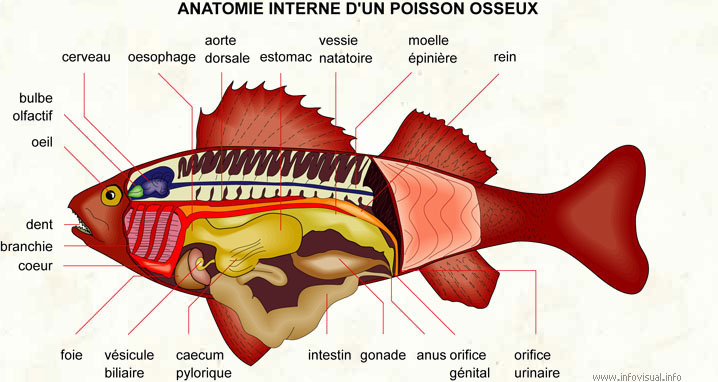Anatomie interne d'un poisson osseux

Cerveau: siège des facultés mentales du poisson.
Oesophage: partie du tube digestif reliant la bouche et l'estomac.
Aorte dorsale: vaisseau sanguin du dos transportant le sang du coeur aux organes.
Estomac: partie du tube digestif située entre l'oesophage et l'intestin.
Vessie natatoire: poche dans laquelle s'accumule l'urine.
Moelle épinière: partie du système nerveux reliant le cerveau à toutes les parties du poisson.
Rein: organe de purification sanguine.
Orifice urinaire: ouverture relative à l'urine.
Orifice génital: ouverture relative aux organes génitaux.
Anus: terminaison du tube digestif.
Gonade: glande sexuelle du poisson sécrétant des hormones.
Intestin: dernière partie du tube digestif.
Caecum pylorique: cul-de-sac relatif à l'intestin.
Vésicule biliaire: petit sac contenant de la bile.
Foie: glande digestive fabriquant la bile.
Coeur: organe de pompage sanguin.
Branchie: organe respiratoire du poisson.
Dent: organe dur du poisson servant à déchiqueter les aliments.
Oeil: organe visuel du poisson.
Bulbe olfactif: partie renflée de l'organe responsable de la perception des odeurs.
Photo :

A Piranha or piraña is a member of a family of omnivorous freshwater fish which live in South American rivers. In Venezuelan rivers they are called caribes. They are known for their sharp teeth and an aggressive appetite for meat. Piranhas are not generally violent and have been known to be domesticated in home and office fish tanks. Piranhas belong to the family of Serrasalmidae. Traditionally, only the four genera Pristobrycon, Pygocentrus, Pygopristis, and Serrasalmus are considered to be true piranhas, due to their specialized teeth. However, a recent analysis showed that, if the piranha group is to be monophyletic, it should be restricted to Serrasalmus, Pygocentrus, and part of Pristobrycon, or expanded to include these taxa plus Pygopristis, Catoprion, and Pristobrycon striolatus. Pygopristis was found to be more closely related to Catoprion than the other three piranha genera.
Piranhas are found only in the Amazon basin, in the Orinoco, in rivers of the Guyanas, in the Paraguay-Paraná, and in the São Francisco River systems; some species of piranha have extremely broad geographic ranges, occurring in more than one of the major basins mentioned above, whereas others appear to have much more limited distributions. However, piranha have been introduced into parts of the United States, even being occasionally found in the Potomac River, but they typically do not survive the cold winters of that region. Recently a piranha was caught by a fisherman in the Catawba River in North Carolina. This is the first known case in North Carolina and possibly in the region. Piranha have also been discovered in the Kaptai Lake in South-East Bangladesh. Research is being carried out to establish how piranha have moved to such distant corners of the world from their original habitat. It is anticipated that rogue exotic fish traders have released them in the lake to avoid being caught by anti-poaching forces.